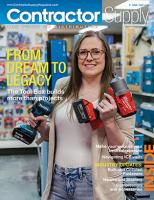Dick Friedman: Tilting at Giants — Successfully
Using your warehouse to compete with Amazon Business and other e-commerce giants.
 Although AmazonSupply is gone, its successor, Amazon Business (AB), is a much greater threat to traditional distributors of specialty tools and fasteners. That’s because AB is set up to make it easy for manufacturers to sell directly to end-users. Other competitors also appear to be trying to take sales and customers away from traditional specialty tool and fastener distributors.
Although AmazonSupply is gone, its successor, Amazon Business (AB), is a much greater threat to traditional distributors of specialty tools and fasteners. That’s because AB is set up to make it easy for manufacturers to sell directly to end-users. Other competitors also appear to be trying to take sales and customers away from traditional specialty tool and fastener distributors.
Price and availability do not appear to be an advantage for any one distributor, but warehouse mistakes made by traditional specialty distributors can result in losing sales to the giants; maybe even losing customers. The giants seldom make warehouse mistakes. This article outlines some measures that traditional specialty distributors can take to ensure that the warehouse is not hurting customer service.
Organization
In the warehouse, there must be adequate heating during cold weather, and adequate ventilation during hot weather. Many of the giant competitors operate out of modern warehouses that are ventilated and heated to make life comfortable for warehouse employees. Heating should not be accomplished with “salamander” type heaters (that generate intense heat that radiates out only a few feet), but with hot air style heaters – that some specialty distributors sell.
And cooling does not require air conditioning; fans with safety cages can move a lot of air and reduce the heat load on employees. Comfortable warehouse workers are motivated to perform their jobs with accuracy.
For every product on the property, each storage location and the quantity stored there must be tracked at all times; even before a product is put away, and after it is loaded on a delivery/shipping truck. If power tools are stored in a secure cage or separate room, they must be tracked like hand tools stored in the main warehouse.
With more and more sales orders coming via the Web at all hours of the day and night, filling an order can involve picking an item from a location other than where it will be stored, including picking from the receiving area if there is no stock in the warehouse.
Every storage location, including floor locations (such as for portable electrical generators), must be labeled with a unique location ID code. And if location-ID bar codes are being scanned, a bar code version of the location ID must be next to the readable location ID.
Furthermore, the ERP system must enable the real-time tracking of the quantity stored at each location, and employees must capture data for every product movement.
Operations
Receiving. Mistakes made here “flow downstream,” and are often not detected until items are picked; sometimes not until customers get the wrong items/quantities. Almost invariably, every receipt of product is proofed against its corresponding PO data (or physical PO), but receiving personnel sometimes assume that the quantities on the packing list are correct, unless data on the vendor’s packing list differs from PO data. This mistake can result in customers not getting the quantities they ordered, or not getting the items at all.
The warehouse manager should inform the people who do the receiving to not hesitate to open shrink wrap and count what has actually been received. If inventory is tracked by piece, but purchased in cases (e.g., pairs of gloves), the number of cases received must be counted, then multiplied by the quantity per case, and the result recorded as received.
Put Away. No item can be picked if its location is unknown, so a very high rate of fulfillment requires recording the storage location as soon as possible. If there is no permanently-assigned storage location, because its location is determined after it is received, the person doing the put away must record the selected
location on any document taken along during put away (e.g. copy of PO) or a form created solely for this purpose or via bar code scanning of the location-ID code. If paper is used, the new location ID must be entered into the system ASAP.
If there is a problem finding a location into which to store an item, the person doing the put away should immediately contact a supervisor. An example is an air compressor that is stored on the floor; the exact storage location may not be known until the unit is positioned in an available storage location.
Picking. Items must picked in a sequence that minimizes picking time, but listing all items on one pick ticket or RF display may not minimize picking time. Minimizing picking time clearly maximizes the likelihood of getting all orders loaded by the end of a normal shift; and counter and will call orders quickly filled.
Timely order filling is one way to compete with the giants, whose modern, heavily-automated warehouses allow rapid fulfillment. But depending on the storage pattern in the warehouse, having one person pick all the lines for an order may take more time than splitting the order into two or more tickets or
RF-displays.
For example, using the same person to get rebar and a reciprocating saw can take longer than generating one pick ticket for the rebar and one for the cutting tool (then bringing them together in a staging area or on a truck) – especially if the rebar will be fabricated.
Packing. On a packing list, line items should be sequenced as data was originally entered for the order, or, for customers who request it, sequenced by job site area, then as entered. If possible, lines on the invoice for the order should be
sequenced the same way. This makes life easier for customer personnel who visually compare packing lists to data in the PO that was Faxed, mailed or transmitted.
The same goes for personnel who proof the invoice to receiving data recorded by other customer personnel. Customer-requested sequencing can be a selling point against new competitors. An example is, cartons of self-tapping screws delivered to one building on a job site, and boxes of saw blades delivered to another building on the same site.
Loading and Delivery. If a customer has several orders to be delivered on same day, all such orders should be consolidated and delivered together. As with
sequencing line items on a packing list, this makes life easier for customer personnel who receive in the items, and reduces delivery costs.
An example is multiple orders received on the same day and that must be delivered to the same building on the same day. A supervisor should arrange the packing lists by delivery address, then building number, and ensure that all the items for the orders are loaded on the same truck, grouped by building.
But there are exceptions; a very heavy or bulky product (e.g., a table saw) may have to be loaded first and secured to the truck body.
The giant competitors may have spent millions of dollars on their warehouses, but traditional specialty tool and fastener distributors can still compete by using these recommendations to make warehouse operations more accurate. CS
Dick Friedman is a recognized expert on warehouse operations, management and technologies for specialty tool and fastener distributors. He is a Certified Management Consultant and is objective and unbiased, so he does NOT SELL warehouse management systems or technologies. Dick uses a 120-point checklist to identify reasons for warehouse mistakes and potential mistakes, and then define improvements that prevent mistakes that can result in lost sales and customers — without getting technology. Call (847) 256-1410 for a FREE consultation, or visit www.GenBusCon.com for more information or e-mail dick@GenBusCon.com.
















